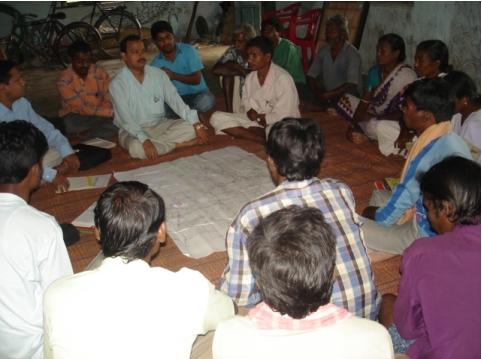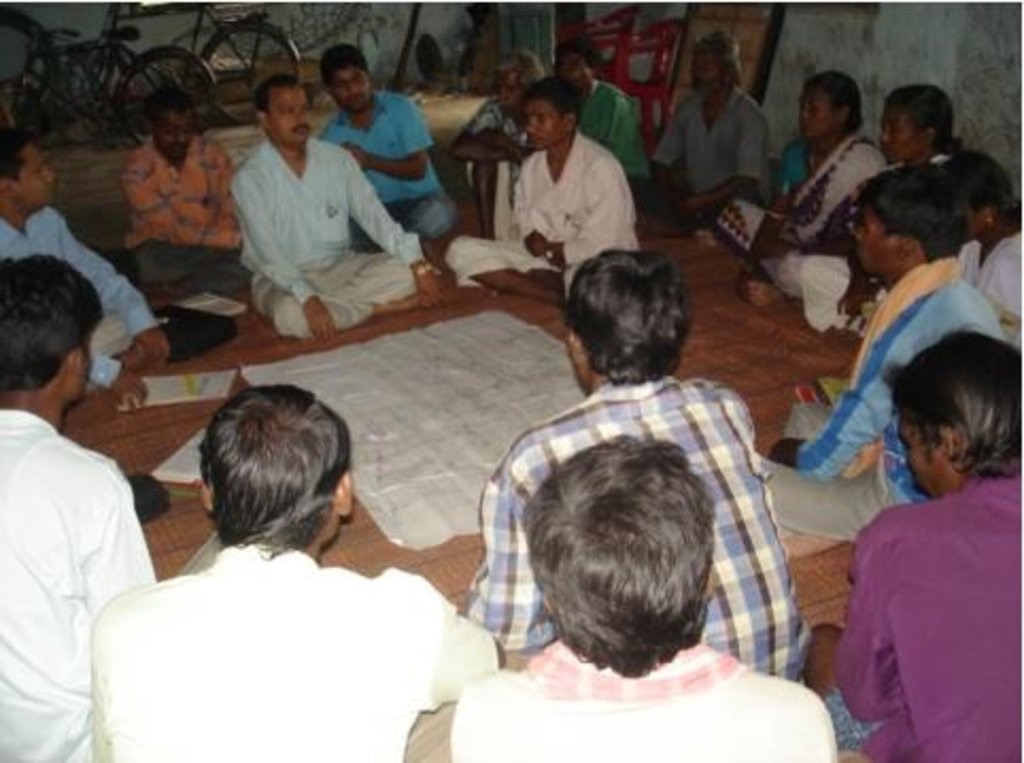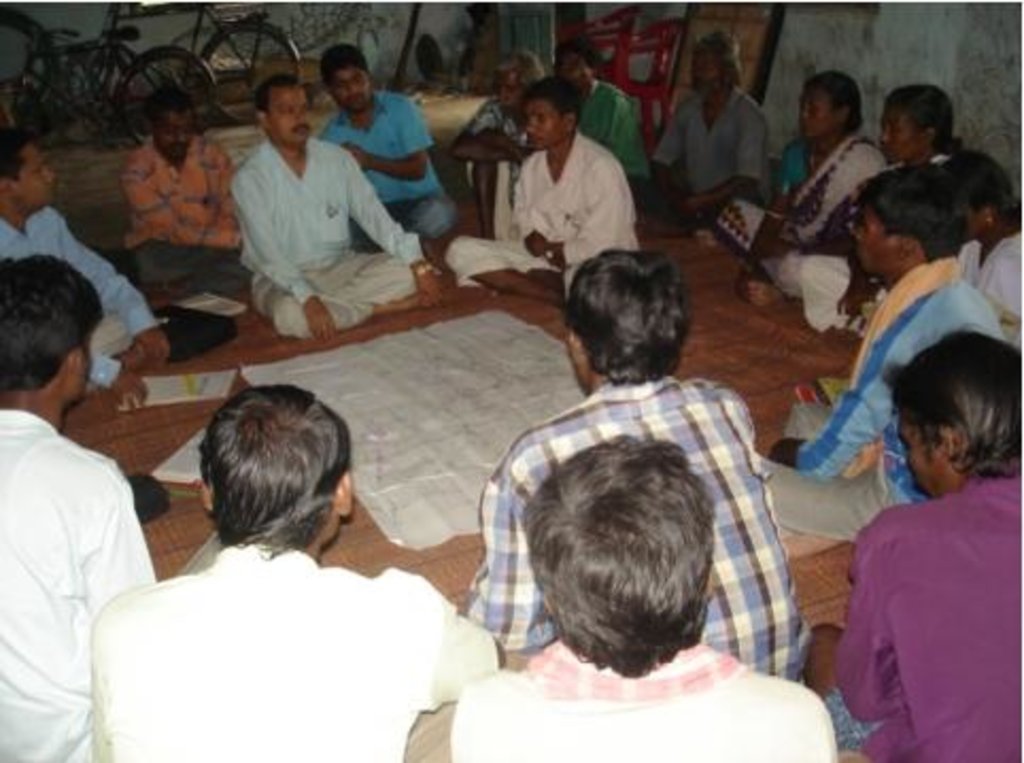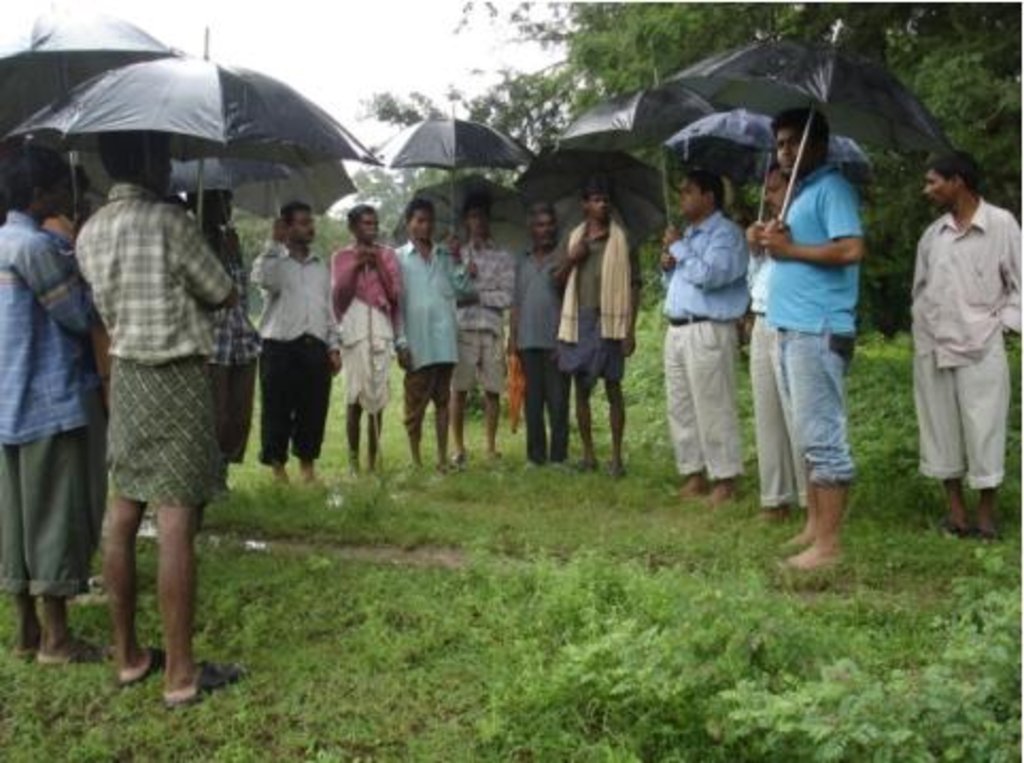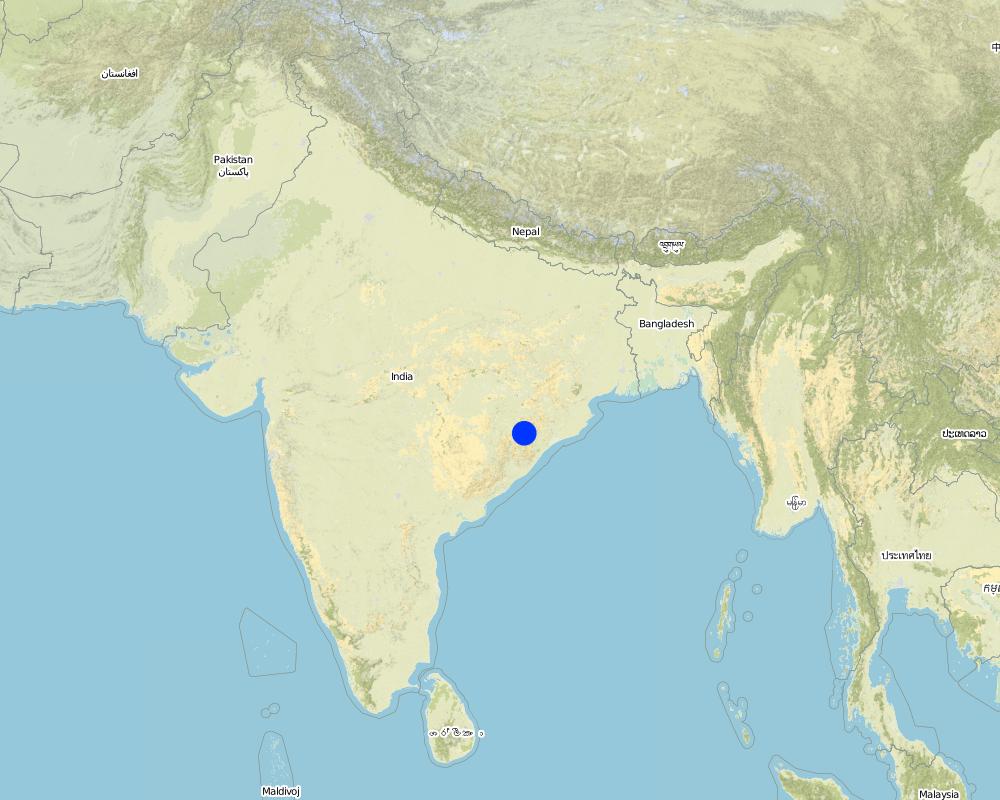Common Interest Group Approach in Watershed Development [Индия]
- Создание:
- Обновить:
- Составитель: Philippe Zahner
- Редактор: –
- Рецензент: Fabian Ottiger
approaches_2366 - Индия
Просмотреть разделы
Развернуть все Свернуть все1. Общая информация
1.2 Контактные данные специалистов и организаций, участвующих в описании и оценке Подхода
Специалист по УЗП:
Название организации (-ий), содействовавших документированию/оценке Подхода (если применимо)
Swiss Agency for Development and Cooperation (DEZA / COSUDE / DDC / SDC) - Швейцария1.3 Условия, регламентирующие использование собранных ВОКАТ данных
Составитель и ответственный/-ые специалист(-ы) согласны с условиями, регламентирующими использование собранных ВОКАТ данных:
Да
1.4 Ссылка (-и) на Анкету (-ы) по Технологиям УЗП
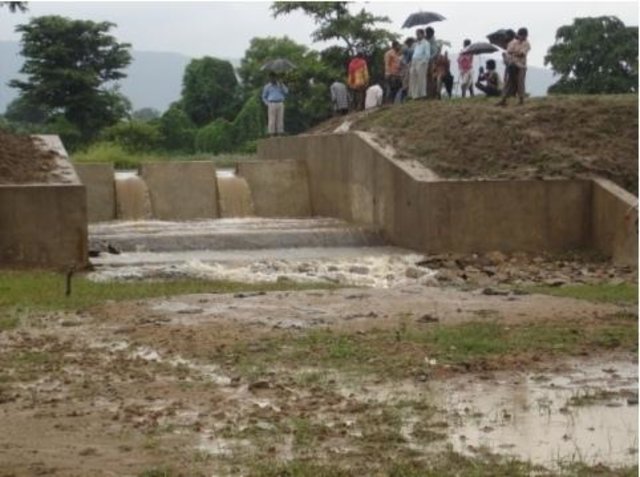
Diversion Weir [Индия]
Diversion weir is a masonary check dam constructed across a perinnial or semi perinnial stream to divert the runoff water into land users field for irrigation.
- Составитель: Niranjan Sahu
2. Описание Подхода УЗП
2.1 Краткое описание Подхода
Group is formed based on a common interest such as irrigation to their fileds from the diversion weir.
2.2 Подробное описание Подхода
Подробное описание Подхода:
Aims / objectives: 1. To creat village level organisation so that post project maintenance is ensured. 2. To encourage community participation in the programme. 3. To ensure equi-distribution of benefits.
Methods: Common Interest group implements the programme, mobilising resources from the watershed committee.
Stages of implementation: 1. Site selection. 2. Layout. 3. Foundation. 4. Construction of Superstructure. 5. Earthen embankment and guidebunds construction. 6. Turfing. 7. Construction of irrigation channel. 8. User's contribution during the process of implementation.
2.3 Фотографии, иллюстрирующие Подход
2.5 Страна/ регион/ место, где применялся Подход
Страна:
Индия
Административная единица (Район/Область):
Orissa
Map
×2.6 Даты начала и окончания реализации Подхода
Год начала реализации:
2005
Год окончания (Если Подход больше не применяется):
2010
2.7 Тип Подхода
- в рамках проекта/ программы
2.8 Каковы цели/ задачи Подхода
The Approach focused mainly on SLM with other activities (Cropping system, Irrigation)
Oranise community into common interest group; build their capacity, provide financial support and guide them to implement their own programme in a participatory manner so that the post project sustainability is ensured and the benefits from the project reaches to the right people with right propertion.
The SLM Approach addressed the following problems: natural calamity(drought); Poverty;Illiteracy; Sustainability in agriculture production, Poor socio economic conditio of the people
2.9 Условия содействующие применению Технологии/ Технологий в рамках Подхода или затрудняющие его
Социальные/ культурные/ религиозные нормы и ценности
- затрудняют
Do not unite to solve a problem
Treatment through the SLM Approach: Organised into groups, identified their common problem and came out the possible solution
Наличие/ доступность финансовых ресурсов и услуг
- затрудняют
People are not able to afford the cost
Treatment through the SLM Approach: WORLP provided financial support for construction of the structure
Нормативно-правовая база (землевладение, права на земле- и водопользование)
- затрудняют
The existing land ownership, land use rights / water rights hindered a little the approach implementation Due to low land holding, the number of land users are high; thus the community mobilisation is less effective.
Осведомленность в области УЗП, доступность технической поддержки
- затрудняют
lack technical knowledge
Treatment through the SLM Approach: SWC specialist assisted in planning, designing and implementation of the structure
3. Участие и распределение ролей заинтересованных сторон
3.1 Заинтересованные стороны, участвующие в реализации Подхода и их роли
- местные землепользователи/ местные сообщества
Working land users were mainly men
Men are worried about the land degradation and irigation where as women are concerned with the types of crops. 45 marginal and small farmers are benefiting from the structure. They were formed into a group and all the group members were involved during the decision making process like selection of site, layout of the channel etc.
- эксперты по УЗП/ сельскому хозяйству
- государственные власти (отвечающие за планирование или принятие решений)
Если участвовало несколько заинтересованных сторон, назовите ведущую организацию:
The concept of common interest group was developed by social scientists.
3.2 Участие местных землепользователей/ местных сообществ на разных стадиях реализации Подхода
| Участие местных землепользователей/ местных сообществ | Перечислите участников и опишите их вовлеченность | |
|---|---|---|
| инициирование/ мотивация | интерактивное | Mainly:rapid/participatory rural appraisal; partly: public meetings; Situational analysis was done using participatory tools like Social map ,Resource map and Transect. |
| планирование | интерактивное | rapid/participatory rural appraisal |
| выполнение | внешняя поддержка | Mainly: responsibility for major steps; partly: casual labour; Community contribution, Quality control, arraning of materials and labours were the major tasks performed by the land users. |
| мониторинг/ оценка | самоорганизация | Mainly: measurements/observations; partly: public meetings; They were taking measurements as per the estimate while the construction was going on. They were also ensuring proper mix of materials while preparing mixtures of sand, cement, chips. |
| Research | нет |
3.4 Принятие решений по выбору Технологии/ Технологий УЗП
Укажите, кто принимал решение по выбору применяемой Технологии/ Технологий:
- в основном землепользователи при поддержке специалистов по УЗП
Поясните:
The selection of site for the structure was decided by the and users along with the SWC speciality.The positive and negative impact of the structure was discussed while finalising the location.
Decisions on the method of implementing the SLM Technology were made by mainly by land users supported by SLM specialists. SWC specilist helped in making the plan and design of the structure. He also assisted while alyout was given in the field.
4. Техническая поддержка, повышение компетенций и управление знаниями
4.1 Повышение компетенций/ обучение
Проводилось ли обучение землепользователей/ других заинтересованных лиц?
Да
Укажите, кто проходил обучение:
- землепользователи
- SWC specialists
Тип обучения:
- в ходе работы
- обмен опытом между фермерами
- опытные участки
Рассматриваемые темы:
Class room as well as on farm training provided to land users.
4.2 Консультационные услуги
Есть ли у землепользователей возможность получать консультации?
Да
Укажите, где именно оказываются консультационные услуги:
- в постоянно функционирующих центрах
Описание/ комментарий:
Name of method used for advisory service: Participatory extension methods and exposure to successful sites, demo plots.; Key elements: Learning by Seeing, Learning by doing; 1) Advisory service was carried out through: projects own extension structure and agents 2) Advisory service was carried out through: projects own extension structure and agents; Extension staff: specifically hired project employees 3) Target groups for extension: land users
Advisory service is inadequate to ensure the continuation of land conservation activities; The staff strength in govt is very less, that is why project has hired experts from open markets and also developed community link workers for extension.
4.3 Институциональная (организационная) поддержка
В ходе реализации Подхода были ли организованы новые институциональные структуры или поддержаны уже существующие?
- да, умеренно
Укажите уровень, на котором структуры были укреплены или вновь созданы:
- местные
Укажите тип поддержки:
- повышение компетенций/ обучение
4.4 Мониторинг и оценка
Являются ли мониторинг и оценка частью Подхода?
Да
Комментарии:
bio-physical aspects were regular monitored through measurements
technical aspects were ad hoc monitored through measurements
socio-cultural aspects were ad hoc monitored through observations
economic / production aspects were ad hoc monitored through observations
area treated aspects were regular monitored through observations
management of Approach aspects were ad hoc monitored through observations
There were few changes in the Approach as a result of monitoring and evaluation: Guidebank constructed to increase temporary storage in the structure. Increased participation and ownership. The CIG strengthened. Views of the land users respected and involved in decision making.
4.5 Научные исследования
Были ли научные исследования частью Подхода?
Да
Укажите темы исследований:
- социология
- технология
Напишите подробнее и назовите тех, кто выполнял исследования:
Technology is looked with gender lens. Participatory technology development is an inbuilt strategy in the WORLP project.
Research was carried out on-farm
5. Финансирование и внешняя материальная поддержка
5.1 Годовой бюджет мероприятий по УЗП в рамках Подхода
Если точный годовой бюжет неизвестен, укажите примерный диапазон затрат:
- 10000-100000
Комментарий (например, основные источники финансирования/ ключевые доноры):
Approach costs were met by the following donors: local community / land user(s) (CIG members (50); Watershed Committee/other members (20)): 70.0%; other (Project Support): 30.0%
5.2 Финансирование и внешняя материальная поддержка, предоставляемая землепользователям
Предоставлялась ли землепользователям финансовая/ материальная поддержка для применения Технологии /Технологий?
Нет
5.3 Субсидии на отдельные затраты (включая оплату труда)
- нет
Если труд землепользователя был существенным вкладом, укажите, был ли этот вклад:
- добровольный
Комментарии:
They contributing their labour for PRA, Planning, meeting etc.
5.4 Кредитование
Предоставлялись ли в рамках Подхода кредиты на мероприятия УЗП?
Нет
6. Анализ влияния и заключительные положения
6.1 Влияние Подхода
Сумел ли Подход помочь землепользователям внедрить и поддерживать технологии УЗП?
- Нет
- Да, немного
- Да, умеренно
- Да, существенно
Got water to their field since the water was diverted. 45-60 acres of land production and productivity increased.
Сумел ли Подход разрешить правовые проблемы землевладения/ землепользования, препятствующие использованию технологий УЗП?
- Нет
- Да, немного
- Да, умеренно
- Да, существенно
Decision making is difficult.
Did other land users / projects adopt the Approach?
- Нет
- Да, немного
- Да, умеренно
- Да, существенно
Other Watershed programme in the state has slowly adopting this approach
6.3 Долгосрочная устойчивость мероприятий в рамках Подхода
Могут ли землепользователи самостоятельно (без внешней поддержки) продолжать применение того, что было реализовано в рамках Подхода?
- да
Если да, опишите как:
They are now empowerd to take their own decisions. They are acting as pressure group and leveraging resources from other line departments.
6.4 Сильные стороны/ преимущества Подхода
| Сильные стороны/ преимущества/ возможности по мнению землепользователей |
|---|
| 'We will manage the Diversion weir, cultivate paddy, ground nut, Onion and Brinjal.' (How to sustain/ enhance this strength: We will maintain this structure from our own contribution.) |
| Сильные стороны/ преимущества/ возможности по мнению составителя или других ключевых специалистов |
|---|
| Community Based Organisation are the local institutions which can manage their own. (How to sustain/ enhance this strength: Limited support as and when required) |
| Self monitoring by the land users |
| Ownership (How to sustain/ enhance this strength: User rights ensured, common fund developed) |
6.5 Слабые стороны/ недостатки Подхода и пути их преодоления
| Слабые стороны/ недостатки/ риски по мнению землепользователей | Возможные пути их преодоления/снижения? |
|---|---|
| Since, SWC is a big investment. If, for some natural calamaity, the structure collapse it will be very difficult to reconstruct. |
| Слабые стороны/ недостатки/ риски по мнению составителя или ответственных специалистов | Возможные пути их преодоления/снижения? |
|---|---|
| Sometime over ambitious since social change is very slow | Expectation should not be raised while mobilising the community |
7. Справочные материалы и ссылки
7.1 Методы сбора/источники информации
- выезды на места, полевые обследования
- опросы землепользователей
Ссылки и модули
Развернуть все Свернуть всеСсылки

Diversion Weir [Индия]
Diversion weir is a masonary check dam constructed across a perinnial or semi perinnial stream to divert the runoff water into land users field for irrigation.
- Составитель: Niranjan Sahu
Модули
Нет модулей


